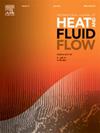Multi-objective optimization of hydrothermal performance of a porous minichannel heat sink using RSM and NSGA-II algorithm
IF 2.6
3区 工程技术
Q2 ENGINEERING, MECHANICAL
International Journal of Heat and Fluid Flow
Pub Date : 2024-10-16
DOI:10.1016/j.ijheatfluidflow.2024.109600
引用次数: 0
Abstract
The key considerations in developing heat sinks for the thermal management of electronic devices are enhancing heat transfer and minimizing entropy generation. This study aims to achieve significant cooling capability with reduced irreversibility by integrating nanofluids and porous media within a circular minichannel heat sink. This heat sink (40 × 40 × 10 mm) is composed of aluminum and is designed to operate within Reynolds numbers of 300–1300, featuring a bronze porous substrate and Fe3O4/water nanofluid coolant. ANSYS Fluent was utilized for computational fluid dynamics simulations, while the Non-dominated Sorting Genetic Algorithm-II was employed to optimize hydrothermal performance. The investigation examined key input parameters, including volume flow rate (Q), nanofluid concentration (φ), porosity (∊), and channel count (n) to optimize the responses: Nusselt number and entropy generation. Latin hypercube sampling is utilized to explore the design space, while Response Surface Methodology developed regression models linking objectives and design variables. The findings demonstrated that a porous channel increases the Nusselt number by approximately 515.12 % and reduces entropy generation by 83.65 % compared to a non-porous channel (∊=1). Moreover, the optimal trade-off between objective functions suggests that enhancing the volume flow rate while reducing the nanofluid concentration, porosity level, and channel count significantly improves the hydrothermal performance of heat sink. Additionally, the optimal Pareto front indicates superior cooling performance with design variables set to Q = 3.239 cm3/s, φ = 1 %, ∊=0.75, and n = 05. This configuration yields a 23.8 % increase in Nusselt number and a 25.2 % decrease in entropy generation compared to the reference study (Q = 0.841 cm3/s, φ = 1 %, ∊=0.75, and n = 05).
使用 RSM 和 NSGA-II 算法对多孔微型通道散热器的水热性能进行多目标优化
开发用于电子设备热管理的散热器的主要考虑因素是加强热传导和最大限度地减少熵的产生。本研究旨在通过在圆形微型通道散热器内集成纳米流体和多孔介质,实现显著的冷却能力并降低不可逆性。该散热器(40 × 40 × 10 毫米)由铝制成,设计工作雷诺数为 300-1300,采用青铜多孔基底和 Fe3O4/ 水纳米流体冷却剂。ANSYS Fluent 用于计算流体动力学模拟,而非优势排序遗传算法 II 则用于优化水热性能。研究考察了关键输入参数,包括体积流量 (Q)、纳米流体浓度 (φ)、孔隙率 (∊) 和通道数 (n),以优化响应:努塞尔特数和熵的产生。利用拉丁超立方采样来探索设计空间,而响应面方法则建立了将目标和设计变量联系起来的回归模型。研究结果表明,与无孔通道(∊=1)相比,多孔通道可将努塞尔特数提高约 515.12%,将熵产生量减少 83.65%。此外,目标函数之间的最佳权衡结果表明,在提高体积流量的同时降低纳米流体浓度、孔隙率水平和通道数量,可显著改善散热器的水热性能。此外,最佳帕累托前沿表明,当设计变量设置为 Q = 3.239 cm3/s、φ = 1 %、∊=0.75 和 n = 05 时,冷却性能优越。与参考研究(Q = 0.841 cm3/s,φ = 1 %,∊=0.75,n = 05)相比,这种配置使努塞尔特数增加了 23.8 %,熵产生量减少了 25.2 %。
本文章由计算机程序翻译,如有差异,请以英文原文为准。
求助全文
约1分钟内获得全文
求助全文
来源期刊

International Journal of Heat and Fluid Flow
工程技术-工程:机械
CiteScore
5.00
自引率
7.70%
发文量
131
审稿时长
33 days
期刊介绍:
The International Journal of Heat and Fluid Flow welcomes high-quality original contributions on experimental, computational, and physical aspects of convective heat transfer and fluid dynamics relevant to engineering or the environment, including multiphase and microscale flows.
Papers reporting the application of these disciplines to design and development, with emphasis on new technological fields, are also welcomed. Some of these new fields include microscale electronic and mechanical systems; medical and biological systems; and thermal and flow control in both the internal and external environment.
 求助内容:
求助内容: 应助结果提醒方式:
应助结果提醒方式:


